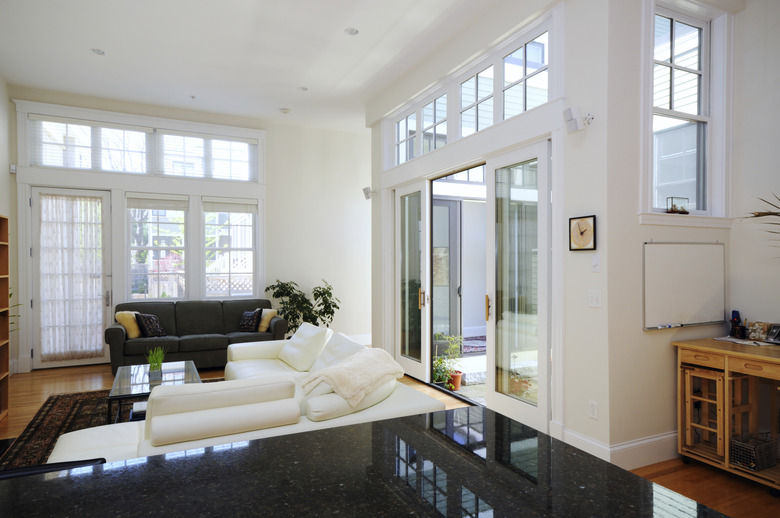Furniture Placement Ideas For A Living Room With A Sliding Door Leading Out To The Patio
A sliding glass door leading to the patio is an asset to your living room, but it can also pose decorating questions. If the view through the door captivates you, thinking of it as focal point for the room helps guide your furniture placement. If you live in an apartment or small house and space is limited or the view less than optimal, there are still ways to incorporate the door as an attractive feature of the room.
Know Your Living Room
Know Your Living Room
Think about the features of your living room and how they'll relate to the sliding door. Here are some of the point to consider:
-
Is the view through the sliding door spectacular or just so-so?
-
What types of activities take place in your living room? For example, do you plan to do party-style entertaining, game or movie night with the family, or quiet activities such as reading?
-
Is it important to have a TV or entertainment center in the living room or can it be located in another part of the house?
-
Identify any usage patterns that might affect the prominence of the patio door. For example, if you primarily use the living room at night when the patio is dark, it may not be important to make sliding door a focal point.
To estimate the actual furniture placement, sketch a floor plan on graph paper. Indicate the sliding door, windows, main entry and any other entries such as a hallway, built-in architectural features, and electrical and electronic outlets. From another sheet of paper, cut shapes to represent your main furniture pieces. The main seating area consists of the sofa, coffee and end tables, and secondary seating such as a love seat and side chairs. Move these pieces around on your sketch to discover your options for placing your furniture.
Patio Door as Focal Point
Patio Door as Focal Point
When you have a lovely view and no other competing focal points, arrange your seating area around the patio door. Place the sofa either facing or at right angles to the door. Turn the love seat or chairs toward the door at right angles to the sofa. The arrangement will look like an open box with the door, the sofa and the secondary seating forming three sides of the box. Fill in with a coffee table in front of the sofa and side chairs, along with lighting and occasional tables to provide a comfortable space. If the room is large, you can create an additional seating area, such as a reader's corner with chair, lamp and bookshelf, away from the door.
Place your furniture so that it doesn't block access to the main entry or any of the walkways to and from or through the room. Place the seating area furnishings close enough and oriented to each other so that it's easy to converse with anyone sitting within the grouping.
To keep the patio door as the room's main focus, consider setting up the TV in another part of the house, such as the family room or den. This will keep the living room serene and focused on the view while eliminating problems with glare on the TV screen from light through the patio door.
Patio Door as Secondary Focal Point
Patio Door as Secondary Focal Point
Some living rooms have two focal points. An architectural feature such as a fireplace, bay window or built-in bookshelves can be as compelling as the patio door. If the feature is on an adjacent wall to the patio door, you might be able to arrange the seating to view both focal points. If you have enough room, place the sofa at an angle that makes both focal points visible. If this isn't possible, choose one architectural feature as the main focal point and arrange your furniture to emphasize it.
Another option is to change your focal point according to season. To do this, you need furniture that is lightweight and portable, such as rattan or modular units. During the spring and summer, arrange your seating area facing the patio door to enjoy the view. When temperatures drop in the fall, move the furniture into a cold-season arrangement around the fireplace.
Minimizing the Patio Door
Minimizing the Patio Door
If the view through your patio door is disappointing, you can obscure the sliding door by placing a folding rice paper screen or hanging a lightweight gauze curtain over it. Make sure your curtain or screen allows light to pass through and doesn't completely block access to the door. Position your furniture to take advantage of a different focal point, such as an architectural feature or entertainment wall. You can place a console table or writing desk in front of the curtain or put the sofa with its back to the sliding door, provided you leave at least 24 to 30 inches as a walkway between the sofa and door.
Small Living Rooms
Small Living Rooms
When space is limited, it's even even more important to plan in advance with paper and pencil. Pare your seating area down to a sofa and love seat or two chairs. Place the sofa either facing or sideways to the sliding door, with the chairs facing or at right angles to the sofa. Avoid using an angled placement, which takes up more room. Put the TV, entertainment center or a bookshelf on the wall adjacent to the sliding door in view of the seating area. If the door's view is unappealing, concealing it with a curtain adds additional wall space for furniture.
